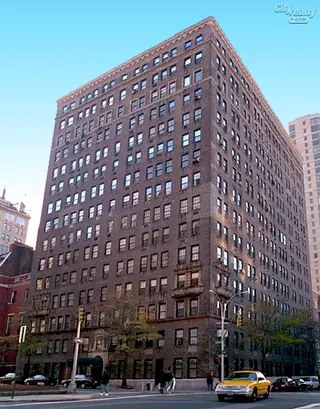 Carter Horsley
Carter HorsleyDec 23, 2011
Carter's Review
This attractive building at 1192 Park Avenue on the northwest corner at 94th Street has a very warm brown brick façade with very attractive and ornate wrought-iron window grills on the first floor.
Located in the heart of the desirable Carnegie Hill neighborhood, it was erected in 1926 and converted to a cooperative in 1952.
The 15-story edifice has 75 apartments.
It was designed by Rosario Candela, who is widely considered to have been the country's greatest designer of luxury apartment buildings and who collaborated with many of the city's most famous architectural firms.
Bottom Line
A large and massive, pre-war building designed by Rosario Candela across 94th Street from the handsome, low-rise, fortress-like Hunter College Campus School.
Description
The lower portion of the first floor has a rough-hewn gray granite base, an interesting alternative to the traditional limestone facing.
The rest of the building is faced with beige brick and the window sills have dentils.
The building has an ornate two-story entrance surround flanked by light sconces and the top of the surround is arched and has two finials. There is a bandcourse above the second floor and another above the 13th floor.
The building has a pair of balconies and window surrounds on the fourth floor at the building’s edges and the 13th floor has plain protruding window surrounds.
The building has a small but ornate cornice and a canopied entrance. It also has protruding air-conditioners and inconsistent fenestration and an exposed rooftop watertank.
Amenities
The building has a doorman and a gym and pets are allowed.
Apartments
Apartment 12C is a three-bedroom unit that has a 20-foot-long entrance gallery that opens onto a 23-foot-long living room with fireplace and a 14-foot-long dining room next to a 15-foot-square kitchen and pantry and a 10-foot-long maid’s room
Apartment 12B is a three-bedroom unit that has a 42-foot-long entrance gallery that leads to a 25-foot-wide living room with a wood-burning fireplace next to a 23-foot-wide dining room next to a pantry and a 13-foot-wide kitchen and a 16-foot-long maid’s room.
Apartment 6Ais a three-bedroom unit that has a 24-foot-long entrance gallery that leads to a 23-foot-long living room with fireplace next to a 14-foot-long dining room next to a 15-foot-long kitchen and a 16-foot-long breakfast/family room and a 12-foot-long staff room. The apartment also has a 17-foot-long library off the gallery.
Apartment 1E is a one-bedroom unit that has a 7-foot-long entry foyer that leads past a 13-foot-long kitchen to a 22-foot-long living/dining room.
History
This building replaced seven, five-story, 19th Century apartment buildings.
Candela collaborated with Cross & Cross on the design of 720 Park Avenue and with Arthur Loomis Harmon on the design of 740 Park Avenue, two of the boulevard's most prestigious structures. He also worked with Cross & Cross on the design of 1 Sutton Place South and his other Park Avenue buildings include 765, 770, 778, 1021, 1105, 1172, and 1220. His other famous buildings include 834 and 960 Fifth Avenue and 19 East 72nd Street.
Candela's buildings, "it is said, were the grandest of the decade that was itself the greatest," wrote Elizabeth Hawes in her book, "New York, New York, How The Apartment House Transformed The Life Of The City (1869-1930)", published by Henry Holt in 1993. "He had a respect for privacy and an eye for significant detail,” she wrote, adding that “he added duplicate water connections to street mains and multiple switches for ceiling lights as well as beautifully turned staircases and separate wine cellars.”
“More significantly,” she continued, “he designed buildings from the inside out. He placed windows where they received light, balanced a room, or allowed a graceful arrangement of furniture.... Candela also invested unusual energy in the entry hall. In a typical apartment, he made it a full-sized room with rich views into the interior because he thought it was important to greet a visitor with a full sense of a home.... Candela liked puzzles. During the Depression, he took up cryptography, and during World War II, he broke the Japanese code."
For more information on Candela see CityRealty.com's entry for 1220 Park Avenue.
According to the Carnegie Hill Architecture Guide published by Carnegie Hill Neighbors, “the round-arched entry surround was originally constructed of pre-cast concrete to emulate limestone.” “Over the years,” it continued, “the concrete deteriorated. In a major renovation in 2006, the entire decorative entry and second story window surround were removed and replaced with carved limestone and finials resembling chess pieces. Above the window is an architrave and segmental pediment with a carved tympanum. A surprise awaits beneath the entrance canopy: a newly designed fanlight, framed in wood with amber-hued leaded glass. At the building base, the concrete bull-nosed string course was replaced with limestone, and concrete blocks were replaced with granite. Candela would have been proud.”
Location
It is directly across the side-street from the Hunter College Campus Schools on part of the former Squadron A Armory site and it is just to the north on the avenue of two very beautiful, low-rise Georgian-style buildings and therefore has considerably more light and air than most apartment buildings on the avenue.
There are many fine private schools in this neighborhood as well as many cultural and religious institutions.

- Co-op built in 1926
- Located in Carnegie Hill
- 75 total apartments 75 total apartments
- 10 recent sales ($750K to $5.2M)
- Doorman
- Pets Allowed
 6sqft delivers the latest on real estate, architecture, and design, straight from New York City.
6sqft delivers the latest on real estate, architecture, and design, straight from New York City.
